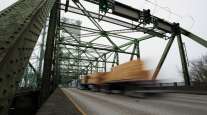Senior Reporter
Neglected Infrastructure Hinders Freight, Agricultural Sectors, Executives Say

WASHINGTON — Congested and deteriorating roadways and inland ports as well as insufficient access to wireless communication in rural communities continues to impede commerce for freight and agricultural industries in farming areas, representatives from rural firms told lawmakers July 19.
Richard Calhoun, representing the National Gain and Feed Association and a former president of Cargo Carriers Inc., explained to the House Committee on Agriculture that infrastructure that exceeded its design life contributes to the rise in cost for movement of goods.
Aging and antiquated infrastructure has already led to an increase in shipping commodities, he said, referring to U.S. Department of Agriculture data. He told the panel the cost of transporting a metric ton of soybeans from Iowa to China increased to $90 from 82 in the past decade. During the same time frame, other world markets that improved their infrastructure have seen lower costs for transporting soybeans, he said.
There has been “an alarming decline in historical competitive advantage that our transportation infrastructure has provided U.S. agriculture and the corresponding increase in investment in critical infrastructure being made by our foreign competitors,” Calhoun said.
In 2012, agriculture accounted for 22% of all tons transported and 31% percent of all ton-miles moved, according to federal data Calhoun shared.
Aside from rebuilding roadways, the executives called for major upgrades to communication capabilities for freight haulers, farmers and residents across rural population centers. Despite technological advances in telecommunications, about 15% of the members of the NTCA-The Rural Broadband Association lack access to adequate broadband, explained Jennifer Otwell, vice president and general manager at Totelcom Communications.
(NTCA is the former National Telecommunications Cooperative Association.)
“Rural broadband has far-reaching effects for both urban and rural America, creating efficiencies in health care, education, agriculture, energy and commerce and enhancing the quality of life for citizens across the country,” Otwell said, speaking on behalf of NTCA–The Rural Broadband Association.
The officials also pressed the Committee on Agriculture to support long-term federal spending in a comprehensive infrastructure measure, arguing most private firms overlook investment opportunities along rural corridors.
Business interests are not alone in expressing concerns about rural areas. State transportation officials also have urged members of Congress to invest in a reliable, well-maintained and safe transportation system in remote places.
“Our nation’s transportation system is one of the key foundational elements necessary to ensure the economic vitality of our country,” Carlos Braceras, executive director of the Utah Department of Transportation, told senators in March.
Agriculture Committee Chairman Mike Conaway (R-Texas) agreed on the need for bipartisan attention to be paid to rural concerns. Both parties aim to target voters from rural districts in the next election. A significant number of those constituents backed President Donald Trump in 2016.
“America’s heartland deserves to be front-and-center as we look to upgrade our aging infrastructure,” Conaway said. “Our manufacturing sector depends on products produced in the heartland to create the ‘Made in America’ products that create jobs and grow our economy.”
“There are a lot of pieces to the infrastructure puzzle, which is why it’s so important they work together,” ranking member Rep. Collin Peterson (D-Minn) added.
In the Senate, West Virginia Republican Shelley Capito has proposed providing tax incentives for investors in certain broadband projects in rural communities.
This fall, the Trump administration intends to unveil a $1 trillion, 10-year infrastructure funding proposal. A preview of the proposal indicated that $200 billion of federal spending would be used to spur private-sector investments. Also the White House indicated that $100 billion would be used for local infrastructure needs, while $25 billion would be designated for rural infrastructure projects.
Transportation Secretary Elaine Chao told lawmakers this year the infrastructure plan also would inject money toward broadband deployments, energy pipelines, electricity transmission and hospitals within the U.S. Department of Veterans Affairs system.
Funding authority for a federal account that assists states with infrastructure projects expires in 2020.




